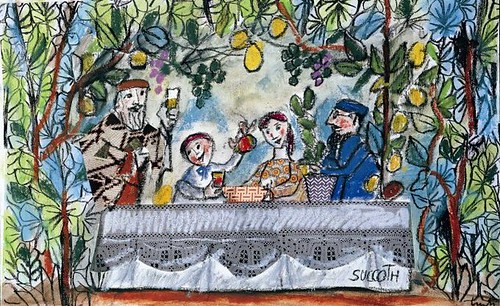seven days in the sukkah we shall sit
 picture: le serigrafie inedite di Emanuele Luzzati
picture: le serigrafie inedite di Emanuele Luzzati"Succoth - La festa delle capanne"
sukkoth is first of one of the three biblical harvest festivals and can be seen as a sort of a jewish equivalent of a thanksgiving holiday. sukkoth lasts 7 days with the first two and last two being full holidays. these last two days have their own names and specifics [to be discussed at another time].
this agricultural celebration required ancient jews to travel, often long distances, to the holy temple in jerusalem to bring their best offerings at the conclusion of the autumn harvest. as mentioned in my previous post, the holiday is called the feast of the tabernacles in english. these tabernacles were the huts or booths that jews lived in during the harvest season. there was no time to return to villages due to the workload. these temporary shelters were built with roofs of foliage.
the temporary dwellings, from which the name of the holiday is derived, also represent the 40 years that jews wandered and survived in the deserts after leaving egypt. it was a structure easily erected and disassembled and was highly moveable. as it says in leviticus:
over the next seven days, jewish men are commanded to eat their main meals, pray and celebrate in these structures. the rest of the family joins them for grand feasts and special prayers. some people will even sleep in them overnight. the sukkah [the hut itself] is decorated and built to specification: at least three sides with the roof made of materials that allow the stars to be seen through openings. bamboo and foliage [such as pine boughs] are used as first choices often.
this site called the sukkah project shows you several examples of some various people have made.
the OU.org site provides beautiful photos of sukkot in jerusalem. click on the link for the slideshow. [i linked this in the entry about etrogim].
not all sukkas are the same. often different countries have different customs for building them and celebration of the holiday. this article briefly speaks of the the sukkas & traditions of the jews of the caucausus, dagestan, kurdistan & yemen.
foods for this holiday are often stuffed — cabbage rolls, peppers, zucchini, tomatoes — all representing plenty. other items which may show up are stuffed pastries like knishes and my favourite .... burekas made of either dough or filo. filled shtrudels are common dessert items. fruits are often cooked with meats, chickens and turkeys stuffed to capacity and a number of casserole dishes are featured on menus. the list of possibilities are endless.
you can also look here to read more about other harvest festivals around the world. no matter what the tradition, we all are thankful in the end for that which sustains us.
this agricultural celebration required ancient jews to travel, often long distances, to the holy temple in jerusalem to bring their best offerings at the conclusion of the autumn harvest. as mentioned in my previous post, the holiday is called the feast of the tabernacles in english. these tabernacles were the huts or booths that jews lived in during the harvest season. there was no time to return to villages due to the workload. these temporary shelters were built with roofs of foliage.
the temporary dwellings, from which the name of the holiday is derived, also represent the 40 years that jews wandered and survived in the deserts after leaving egypt. it was a structure easily erected and disassembled and was highly moveable. as it says in leviticus:
You shall live in booths seven days ... in order that future generations may know that I made the Israelite people live in booths when I brought them out of the land of Egypt, I am the Lord, your G-d."
over the next seven days, jewish men are commanded to eat their main meals, pray and celebrate in these structures. the rest of the family joins them for grand feasts and special prayers. some people will even sleep in them overnight. the sukkah [the hut itself] is decorated and built to specification: at least three sides with the roof made of materials that allow the stars to be seen through openings. bamboo and foliage [such as pine boughs] are used as first choices often.
this site called the sukkah project shows you several examples of some various people have made.
the OU.org site provides beautiful photos of sukkot in jerusalem. click on the link for the slideshow. [i linked this in the entry about etrogim].
not all sukkas are the same. often different countries have different customs for building them and celebration of the holiday. this article briefly speaks of the the sukkas & traditions of the jews of the caucausus, dagestan, kurdistan & yemen.
foods for this holiday are often stuffed — cabbage rolls, peppers, zucchini, tomatoes — all representing plenty. other items which may show up are stuffed pastries like knishes and my favourite .... burekas made of either dough or filo. filled shtrudels are common dessert items. fruits are often cooked with meats, chickens and turkeys stuffed to capacity and a number of casserole dishes are featured on menus. the list of possibilities are endless.
you can also look here to read more about other harvest festivals around the world. no matter what the tradition, we all are thankful in the end for that which sustains us.
* * * * *
the first north american thanksgiving occured in 1578 in newfoundland
&
the first canadian thanksgiving on april 15, 1872
&
the first canadian thanksgiving on april 15, 1872
april, huh? interesting. now the holiday occurs on the second monday of october every year. definitely a moveable feast.
though from a kids site, this is interesting information about canadian thanksgiving.
though from a kids site, this is interesting information about canadian thanksgiving.





0 comments:
Post a Comment